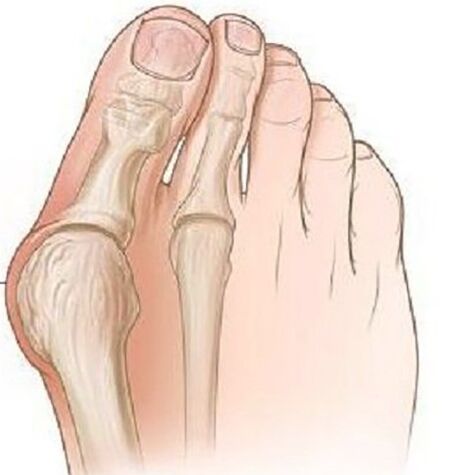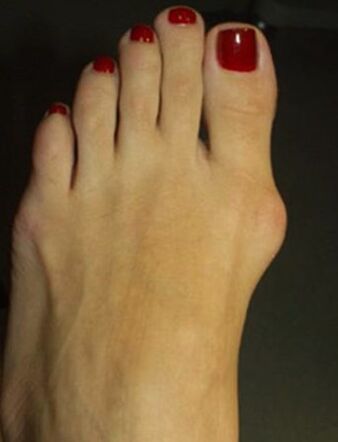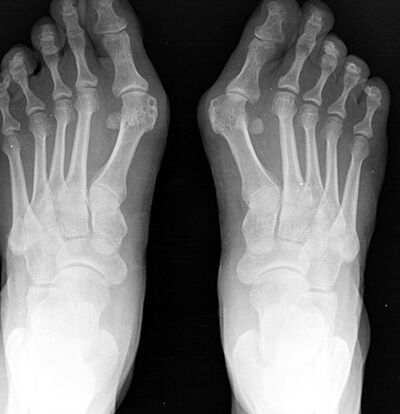Valvular deformation of the thumb of the foot is the most common deformation obtained by the foot, characterized by a deviation of the thumb outward.
Pathology is bilateral in nature and mainly affects women over the age of 35.In most cases, deformation is accompanied by chronic inflammation of the joint pocket and joint deformity of the positive nasal connection, and the positive deviation of the first meta bone.

Causes of the disease.Why is it dangerous?
The causes of valgus deviation in the toe have not been fully studied.There are several theories that occur:
- Genetic theory.In the mid-19th century, it was believed that only the model could undergo this deformation due to the use of model shoes in the upper floors, but in research, this pathology was found in men wearing flat shoes.
- The theory of first-order muscle weakness - refuted in a detailed study of the problem.
- The theory of weakness of ligaments and the only painlessness - most scientists adhere to this theory.
There are many factors that lead to the debut of this pathology:
- Excessive weight increases the load on the feet.
- Changes in age-related muscular dystrophy.
- The weekly magazine of high heels is over 5 cm, shrinking to the toes.
- Existing deformation of bones (scoliosis, extroverted deformation of femur and knee joints, flattening feet).
The danger of pathology lies in the fact that over time, this deformation leads to posture deformation. Due to improper distribution of load during walking and improper damage to the muscles of the feet, it is possible to form muscular dystrophy depths of spine, hip and knee dystrophy, which will be accompanied by persistent pain, which will lead to a person's kindness, which will worsen a person's friendly person.
Clinical manifestations
At the onset of the disease, valgus deformation is not clinically manifested.Most women are more concerned with the increase in the foot of the metacarpal bone-mening joint, while the burst of the first finger becomes obvious.

As time goes by, the pain occurs, first by wearing narrow shoes and long walking, and then the pain begins to become persistent, painful.
Due to the improper distribution of weight, the limbs are the first and second fingers on the sole, formed from corn, the second finger is lifted and expanded extensively to form the "malt porridge" fingers, which makes the walk very complicated.Arthritis and chronic cystitis occur due to blood circulation and deterioration of nerves in the front of the foot.
diagnosis
- During the objective inspection, the classic deformation of the thumb's outward deviation can be seen, and the distal part of the foot can be expanded.In the projection of the first meta bone, there are signs of hairy - congestion and skin edema, pain during palpation.
- X-rays of the feet are in two predictions.The anterior projection determines the degree of the thumb, the state of the metacarpal bone-mening joint, the degree of displacement of the sesame bone, and in the lateral projection, the degree of flat feet is visualized and calculated, usually when oral deviations of the first finger.
- botany.On the print of the foot made on the foot, a line is drawn through the center of the heel, as well as the fourth and third fingers, the outer composition of the foot is formed, according to the existence of the foot, its presence and its measurement.In these patients, level 1 flat feet or flat feet are more often detected.
Treatment and prevention
Conservative or surgical treatment is performed depending on the severity of the process.
Conservative treatment was performed during the mild phase of the disease, using various types of orthopedic insoles, which were selected individually and brought the deformed fingers to their normal position, while the load on the anterior side of the limb was stable and distributed.
In children and old age, transverse bandages of the distal limb are used, placed between the first and second fingers.To relieve pain, use a warm bath with sea salt and soda, a ra bath can bring good results.
To combat capsuleitis, topical anti-inflammatory gels were used, metal oxides and lidocaine compression was used, and obvious pain, Novocaine blockade and intra-articular injection of glucocorticoids were used.

At any stage of the disease, surgical treatment can be performed under local anesthesia, which reduces the list of surgical contraindications.
In the first stage, the growth of bone cold is removed on the inner edge of the bone, which can only relieve pain in the process but cannot prevent future deformation and development.
In the presence of a flat foot, severe deviation of the fingers were performed with bone blades at the bottom of the first finger to reject the fingers to normal position with the help of Lavsan tape, forming the transverse ligament of the sole.After the operation, the legs are tightly secured with bandages for 4 weeks, and it is recommended to use a single orthopedic insole during this year.
Preventing this disease is to use comfortable shoes without high heels, the shoes should sit freely on the legs and narrow toes should not cause discomfort to the thumb.If there is any deformation of the bone, it is recommended that the orthopedic doctor perform a preventive examination to identify and slow the progress of peripheral deformation of the toe.
Consequences and complications
One complication of this process is the development of the foot or the development of the foot "March" which is characterized by acute pain, which is due to microcracks in the paired joints of the foot and tendinitis.
There is a risk of skeletal malignancy due to ongoing inflammatory processes and mechanical damage.























